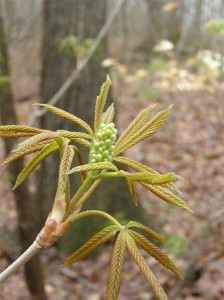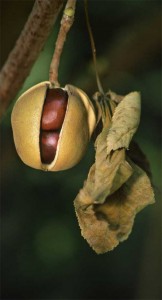Painted buckeyes

This emergence of painted buckeye shows the reddish scales of the terminal bud with immature five-fingered leaves surrounding the infant cluster of pale-yellow flower buds. Photo by Ken Moore
By Ken Moore
I look forward to the spring awakening of the painted buckeye, Aesculus sylvatica, locally common in old erosion gullies and flood plains.
I think of tiny hands when I see those five-fingered (palmately compound) leaves emerge from the large buds of this small tree that we see mostly as a large open shrub. It seldom attains a height of more than 20 feet. Some of the buds began opening a couple of weeks ago and by now those distinctive leaves are fairly well formed.
This past weekend, some buds were still holding their reddish protective bud scales with infant leaves reaching out, some surrounding a cluster of pale lime-green flower buds.
In just a week or two, those bud clusters will mature into tubular yellowish flowers, sometimes with pink- or salmon-colored tints. Retrace your steps in the late summer and early fall and you will be amazed that a few of those flowers will have matured to large capsules, splitting open to reveal one to three cinnamon brown-colored buckeye fruits. Each fruit does, indeed, look like the big eye of a doe or buck.
Paul Green was a keen observer of people and plants. I remember well the following reminiscence from Paul Green’s Plant Book.
“A buckeye nut or kernel was often carried in the pocket as a good luck charm. As a boy I carried one for several months but after a spell of what I thought was bad luck I threw it away.
My friend Mr. Mac said that his mother used buckeyes as a source of starch for clothes. He had heard from old folks too, he said, that the Indians would pound the kernels into a meal, mix it with beaten corn and water and throw the mush into rivers and creeks. The fish would eat it and get drunk on it and rise to the top and then were easy to catch as they floated on the water.â€
Make note that buckeyes are poisonous, so humans should not try ingesting this concoction!
The painted buckeye is restricted to our Piedmont region. It is related to the yellow buckeye, Aesculus flava, the big tree of our mountain forests. It is also related to the beautiful red-flowered red buckeye, Aesculus pavia, a small tree of our coastal plain.
Some years ago, the red buckeye was introduced into cultivation in our Piedmont region and has become quite popular, being planted even in the highway median of our local bypass. Sadly, this red buckeye is beginning to seed around very liberally and shows signs of becoming an undesirable invasive in our local woods. I urge gardeners to refrain from planting the red buckeye. We need to be aware that even our own native plants can sometimes become “exotic invasives†when spread beyond the region of their natural distribution.
This week, seek out the painted buckeye common in the woods around us and appreciate it as a part of the region we call home. And follow it through the seasons to enjoy the flowers, mature leaves and eventually those “bad-luck†lucky buckeyes.
Two reminders:
*See Dutchman’s breeches this Sunday afternoon, March 22. Check the Eno River Spring Wildflower Hikes website.
*Copper-colored leaves are still hanging on most beech trees. Begin daily observations now. I’ll wager most of them will drop over a single night a day or two before April 1.

Some of the yellow flowers of painted buckeye (top) mature to buckeye fruit (bottom) in the late summer. Photos by Betsy Green Moyer



Comments are closed.